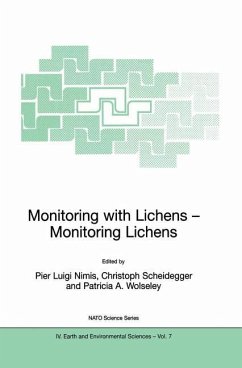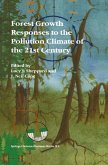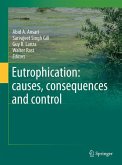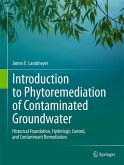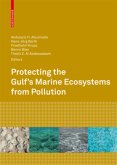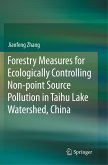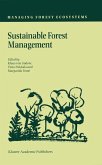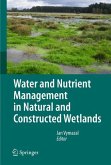Nimis
Monitoring with Lichens - Monitoring Lichens
Herausgegeben:Nimis, Pier Luigi; Scheidegger, Christoph; Wolseley, Patricia A.
Nimis
Monitoring with Lichens - Monitoring Lichens
Herausgegeben:Nimis, Pier Luigi; Scheidegger, Christoph; Wolseley, Patricia A.
- Gebundenes Buch
- Merkliste
- Auf die Merkliste
- Bewerten Bewerten
- Teilen
- Produkt teilen
- Produkterinnerung
- Produkterinnerung
A comprehensive, up-to-date review of lichens as biomonitors of air pollution (bioindication, metal and radionuclide accumulation, biomarkers), and as monitors of environmental change (including global climate change and biodiversity loss) in a wide array of terrestrial habitats. Several methods for using lichens as biomonitors are described in a special section of the book.
Andere Kunden interessierten sich auch für
![Forest Growth Responses to the Pollution Climate of the 21st Century Forest Growth Responses to the Pollution Climate of the 21st Century]() SheppardForest Growth Responses to the Pollution Climate of the 21st Century115,99 €
SheppardForest Growth Responses to the Pollution Climate of the 21st Century115,99 €![Eutrophication: causes, consequences and control Eutrophication: causes, consequences and control]() Eutrophication: causes, consequences and control113,99 €
Eutrophication: causes, consequences and control113,99 €![Introduction to Phytoremediation of Contaminated Groundwater Introduction to Phytoremediation of Contaminated Groundwater]() James E. LandmeyerIntroduction to Phytoremediation of Contaminated Groundwater139,99 €
James E. LandmeyerIntroduction to Phytoremediation of Contaminated Groundwater139,99 €![Protecting the Gulf's Marine Ecosystems from Pollution Protecting the Gulf's Marine Ecosystems from Pollution]() Hans-Jürgen Barth (ed.)Protecting the Gulf's Marine Ecosystems from Pollution75,99 €
Hans-Jürgen Barth (ed.)Protecting the Gulf's Marine Ecosystems from Pollution75,99 €![Forestry Measures for Ecologically Controlling Non-point Source Pollution in Taihu Lake Watershed, China Forestry Measures for Ecologically Controlling Non-point Source Pollution in Taihu Lake Watershed, China]() Jianfeng ZhangForestry Measures for Ecologically Controlling Non-point Source Pollution in Taihu Lake Watershed, China75,99 €
Jianfeng ZhangForestry Measures for Ecologically Controlling Non-point Source Pollution in Taihu Lake Watershed, China75,99 €![Sustainable Forest Management Sustainable Forest Management]() Klaus von Gadow / T. Pukkala / Margarida Tom‚ (Hgg.)Sustainable Forest Management153,99 €
Klaus von Gadow / T. Pukkala / Margarida Tom‚ (Hgg.)Sustainable Forest Management153,99 €![Water and Nutrient Management in Natural and Constructed Wetlands Water and Nutrient Management in Natural and Constructed Wetlands]() Water and Nutrient Management in Natural and Constructed Wetlands112,99 €
Water and Nutrient Management in Natural and Constructed Wetlands112,99 €-
-
-
A comprehensive, up-to-date review of lichens as biomonitors of air pollution (bioindication, metal and radionuclide accumulation, biomarkers), and as monitors of environmental change (including global climate change and biodiversity loss) in a wide array of terrestrial habitats. Several methods for using lichens as biomonitors are described in a special section of the book.
Produktdetails
- Produktdetails
- Nato Science Series: IV: 7
- Verlag: Springer / Springer Netherlands
- Artikelnr. des Verlages: 978-1-4020-0429-2
- 2002
- Seitenzahl: 424
- Erscheinungstermin: 31. Januar 2002
- Englisch
- Abmessung: 241mm x 160mm x 28mm
- Gewicht: 771g
- ISBN-13: 9781402004292
- ISBN-10: 140200429X
- Artikelnr.: 22069568
- Herstellerkennzeichnung
- Springer-Verlag GmbH
- Tiergartenstr. 17
- 69121 Heidelberg
- ProductSafety@springernature.com
- Nato Science Series: IV: 7
- Verlag: Springer / Springer Netherlands
- Artikelnr. des Verlages: 978-1-4020-0429-2
- 2002
- Seitenzahl: 424
- Erscheinungstermin: 31. Januar 2002
- Englisch
- Abmessung: 241mm x 160mm x 28mm
- Gewicht: 771g
- ISBN-13: 9781402004292
- ISBN-10: 140200429X
- Artikelnr.: 22069568
- Herstellerkennzeichnung
- Springer-Verlag GmbH
- Tiergartenstr. 17
- 69121 Heidelberg
- ProductSafety@springernature.com
1. Monitoring with Lichens - Monitoring Lichens: An Introduction.- Section 1. Lichens as Indicators of Pollution.- 2. Monitoring Lichens as Indicators of Pollution: An Introduction.- 3. Bioindication: Calibrated Scales and their Utility.- 4. Bioindication: The I.A.P. Approach.- 5. Bioindication: The Community Approach.- 6. Accumulation of Inorganic Contaminants.- 7. Lichens as Monitors of Radioelements.- 8. Biomarkers of Pollution-Induced Oxidative Stress and Membrane Damage in Lichens.- 9. Key Issues in Designing Biomonitoring Programmes: Monitoring scenarios, sampling strategies and quality assurance.- Section 2. Monitoring Lichen Diversity and Ecosystem Function.- 10. Monitoring Lichen Diversity and Ecosystem Function: An Introduction.- 11. Methods for Monitoring Biodiversity and Ecosystem Function: Monitoring scenarios, sampling strategies and data quality.- 12. Monitoring Lichens for Conservation: Red Lists and Conservation Action Plans.- 13. Lichen Monitoring and Climate Change.- 14. Monitoring Biodiversity and Ecosystem Function: Forests.- 15. Monitoring Biodiversity and Ecosystem Function: Grasslands, Deserts, and Steppe.- 16. Monitoring Lichens on Monuments 239.- 17. Monitoring Maritime Habitats.- Section 3. Methods for Monitoring Lichens.- 18. Methods for Monitoring Lichens: An Introduction.- 19. Mapping Lichen Diversity as an Indicator of Environmental Quality.- 20. Identifying Deviations from Naturality of Lichen Diversity for Bioindication Purposes.- 21. Epiphytes on Wayside Trees as an Indicator of Eutrophication in the Netherlands.- 22. Using Lichens on Twigs to Assess Changes in Ambient Atmospheric Conditions.- 23. Guidelines for the Use of Epiphytic Lichens as Biomonitors of Atmospheric Deposition of Trace Elements.- 24. Transplanted Lichens forBioaccumulation Studies.- 25. Sample Preparation of Lichens for Elemental Analysis.- 26. Sulphur Isotopes in Lichens as Indicators of Sources.- 27. Estimation of Critical Levels of Air Pollution (Metals) on the Basis of Field Study of Epiphytic Lichen Communities.- 28. Monitoring Physiological Change in Lichens: Total Chlorophyll Content and Chlorophyll Degradation.- 29. Chlorophyll Fluorescence Measurements in the Field: Assessment of the Vitality of Large Numbers of Lichen Thalli.- 30. Measuring Bark pH.- 31. A Photographic Quadrat Recording Method Employing Image Analysis of Lichens as an Indicator of Environmental Change.- 32. Site Assessment of Epiphytic Habitats Using Lichen Indices.- 33. Indicator Species - Restricted Taxa Approach in Coniferous and Hardwood Forests of Northeastern America.- 34. Monitoring Regional Status and Trends in Forest Health with Lichen Communities: The United States Forest Service Approach.- 35. Biodiversity Assessment Tools - Lichens.- 36. Using Lichens and Bryophytes to Evaluate the Effects of Silvicultural Practices in Tasmanian Wet Eucalypt Forest.- 37. Using Corticolous Lichens of Tropical Forests to Assess Environmental Changes.- 38. Lichenometry.- 39. Transplanting Lichen Fragments for Provenance-Clone Tests.- 40. Assessing Changes in Density and Condition of Lichens for Species Recovery Programmes.- 41. Monitoring Red-Listed Lichens using Permanent Plots.- 42. A Method for Detecting Large-Scale Environmental Change with Lichens.
1. Monitoring with Lichens - Monitoring Lichens: An Introduction.- Section 1. Lichens as Indicators of Pollution.- 2. Monitoring Lichens as Indicators of Pollution: An Introduction.- 3. Bioindication: Calibrated Scales and their Utility.- 4. Bioindication: The I.A.P. Approach.- 5. Bioindication: The Community Approach.- 6. Accumulation of Inorganic Contaminants.- 7. Lichens as Monitors of Radioelements.- 8. Biomarkers of Pollution-Induced Oxidative Stress and Membrane Damage in Lichens.- 9. Key Issues in Designing Biomonitoring Programmes: Monitoring scenarios, sampling strategies and quality assurance.- Section 2. Monitoring Lichen Diversity and Ecosystem Function.- 10. Monitoring Lichen Diversity and Ecosystem Function: An Introduction.- 11. Methods for Monitoring Biodiversity and Ecosystem Function: Monitoring scenarios, sampling strategies and data quality.- 12. Monitoring Lichens for Conservation: Red Lists and Conservation Action Plans.- 13. Lichen Monitoring and Climate Change.- 14. Monitoring Biodiversity and Ecosystem Function: Forests.- 15. Monitoring Biodiversity and Ecosystem Function: Grasslands, Deserts, and Steppe.- 16. Monitoring Lichens on Monuments 239.- 17. Monitoring Maritime Habitats.- Section 3. Methods for Monitoring Lichens.- 18. Methods for Monitoring Lichens: An Introduction.- 19. Mapping Lichen Diversity as an Indicator of Environmental Quality.- 20. Identifying Deviations from Naturality of Lichen Diversity for Bioindication Purposes.- 21. Epiphytes on Wayside Trees as an Indicator of Eutrophication in the Netherlands.- 22. Using Lichens on Twigs to Assess Changes in Ambient Atmospheric Conditions.- 23. Guidelines for the Use of Epiphytic Lichens as Biomonitors of Atmospheric Deposition of Trace Elements.- 24. Transplanted Lichens forBioaccumulation Studies.- 25. Sample Preparation of Lichens for Elemental Analysis.- 26. Sulphur Isotopes in Lichens as Indicators of Sources.- 27. Estimation of Critical Levels of Air Pollution (Metals) on the Basis of Field Study of Epiphytic Lichen Communities.- 28. Monitoring Physiological Change in Lichens: Total Chlorophyll Content and Chlorophyll Degradation.- 29. Chlorophyll Fluorescence Measurements in the Field: Assessment of the Vitality of Large Numbers of Lichen Thalli.- 30. Measuring Bark pH.- 31. A Photographic Quadrat Recording Method Employing Image Analysis of Lichens as an Indicator of Environmental Change.- 32. Site Assessment of Epiphytic Habitats Using Lichen Indices.- 33. Indicator Species - Restricted Taxa Approach in Coniferous and Hardwood Forests of Northeastern America.- 34. Monitoring Regional Status and Trends in Forest Health with Lichen Communities: The United States Forest Service Approach.- 35. Biodiversity Assessment Tools - Lichens.- 36. Using Lichens and Bryophytes to Evaluate the Effects of Silvicultural Practices in Tasmanian Wet Eucalypt Forest.- 37. Using Corticolous Lichens of Tropical Forests to Assess Environmental Changes.- 38. Lichenometry.- 39. Transplanting Lichen Fragments for Provenance-Clone Tests.- 40. Assessing Changes in Density and Condition of Lichens for Species Recovery Programmes.- 41. Monitoring Red-Listed Lichens using Permanent Plots.- 42. A Method for Detecting Large-Scale Environmental Change with Lichens.

